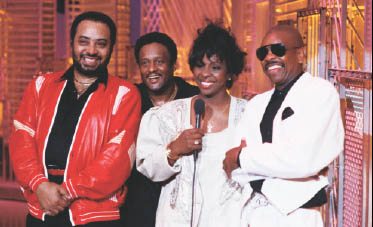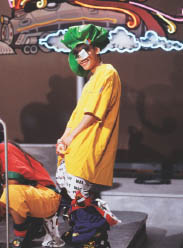THE BIG MOMENTS
As I pored over the episode lists of the 1990s, I was struck by how many of the big moments were throwbacks to the early days of the show, and by extension to the good old days of soul music. Many of the most compelling shows were tributes to icons who had started out as working musicians, and whose appearances on the show had helped them grow into icons. I also noticed how balanced the show had become, gender-wise: by the nineties, Soul Train was a consistent and reliable showcase for the rising female forces of hip-hop and soul. But perhaps the biggest moment of them all came without warning.

Both heroes to their public, Quincy Jones and Don talk shop.
Tribute to Quincy Jones
Episode 643 was definitely a nice surprise for me and one of the better shows of the 1990s. On October 20, 1990, Soul Train celebrated Quincy Jones’s thirty-five years in music with an all-star tribute. It was probably the most star-studded show ever, with Kool Moe Dee, Melly Mel, Ice-T, and Big Daddy Kane (they were all there to celebrate the Back on the Block album), along with El DeBarge, the Winans, Al B. Sure!, Siedah Garrett, and Tevin Campbell. The show also featured clips of Quincy’s documentary Listen Up. In this one episode, Don managed to cram in dancing to Quincy’s hit songs; airing the Chaka Khan and Ray Charles video of their 1990 remake of Quincy’s 1976 “I’ll be Good to You,” originally performed by the Brothers Johnson; having serious one-on-one time in two very long interview segments with Don; and celebrities singing in Quincy’s honor. I call this episode “a great day on Soul Train.”

All the top hip-hop stars came to pay tribute to Quincy Jones, including Kool Moe Dee and Ice-T.

It’s déjà vu all over again, as the audience sings a new Soul Train theme song with Stevie Wonder.
Tribute to Stevie Wonder
The debut episode of Season 21 on September 21, 1991, is my other top pick from the ’90s. Episode 671 was a tribute to Stevie Wonder. First coming aboard in Soul Train’s second year to help out the show in its fledgling stage, Stevie returned eighteen years later for a reunion of iconic artists. It was nice to see Stevie and Don together again; it felt like Stevie had returned home. This episode marked a unique time when an artist who had become bigger than the show decided to visit again. As Don displayed what had become rare signs of brotherly affection and happiness, it seemed like he couldn’t contain his enthusiasm. He was almost in tears and even kissed Stevie on the top of his head.
Stevie performed tracks off his Jungle Fever soundtrack and conducted three long interview segments with a live piano. As Wonder-esque as ever, he sang an impromptu live medley of his hits, similar to the first two times he was on the show. As a gift to the generation who had witnessed Stevie’s previous Soul Train appearances—as well as to the generation who hadn’t yet experienced them—Don aired the clip from Episode 46 in 1973 of Stevie singing his version of the Soul Train theme song. When they cut back to the present, Stevie was surrounded by the dancers, a re-creation of the iconic moment. The younger kids were singing the songs as loud, or louder, than Stevie, which brought the show full circle. And then he outdid himself. Stevie turned “Superstition” into another Soul Train theme song and closed the show while singing to the credits, “Time to get on Soul Train, time to get on board.”

Don was really relishing this moment with Stevie.
Tribute to Gladys Knight
It was sentimental when Gladys Knight came back for her tribute show on October 5, 1991. Don was sure to pass on to each generation of his viewers the fact that she was the very first performer on the show. For Episode 673, Gladys returned almost twenty years to the day from the inaugural episode on October 2, 1971. I’m sure the apropos timing was planned. Don always let it be known on all her shows that he hosted (she made seven appearances from 1971 to 1993) that “if it weren’t for Gladys Knight, none of this would be here.” What is probably most notable about this appearance is that Gladys had a hit with the Calloway brothers at the time called “Love Overboard,” so she wasn’t riding off the fumes of her past. She and the Pips had a top five R&B hit on their hands and were still showing the way.

On May 4, 1974, Gladys Knight & the Pips performed five of their hits: “Neither One of Us,” “Midnight Train to Georgia,” “You’re the Best Thing That Ever Happened to Me,” “I Got to Use My Imagination,” and “On and On.”

Gladys Knight, in Episode 33 on September 23, 1972, had reached icon status at the astonishingly young age of twenty-seven.

They started it all in Episode 1: Gladys Knight & the Pips return in Episode 33.

Coming full circle, Gladys Knight & the Pips are given a tribute show in Episode 564 on April 9, 1988.
Gerald and Eddie Levert
Episode 690 could’ve been called 360, since it was literally full circle, as two of my favorite Leverts—father Eddie and son Gerald—had a go-round with Don. The history here was thick, not only between Don and Eddie, but between Eddie and his son, whom Eddie helped to become a star. Eddie called in every favor and leveraged every resource in order to see his son’s ambitions reached. And by February 29, 1992, Gerald’s success had eclipsed his father’s. By that time, Gerald’s celebrity was due to a wave of top five hits: “Casanova,” “Pop, Goes My Mind,” “My Forever Love,” “Sweet Sensation,” “Addicted to You,” “Just Coolin’,” and “Baby I’m Ready.” Now father needed son, and where better to show off as a collaborative team, performing together, than on Soul Train.
Move to Movies
Episode 679 on November 16, 1991, was different beyond compare because the show was dedicated to the successful movie brought to us by Doug McHenry and George Jackson, House Party 2. Don introduced the show as a “tribute to the House Party soundtrack.” This episode is the actual manifestation of the Soul Train domino effect. In paying tribute to House Party 2, Don was giving a homecoming to his offspring—the new onslaught of black executive producers, directors, and writers who were making an above-the-radar impact in the mainstream. With Soul Train being the original medium credited with opening doors for such behind-the-scenes African American talent, this was a kiss-the-ring-worthy moment. The show was in line with Quincy Jones’s episode of the prior season, with artists Kid ’n Play, Tony! Toni! Toné!, and Ralph Tresvant performing tracks off the soundtrack, except now Don was saluting a product instead of a person.
Introducing Girl Power
Soul Train gave women a platform that enabled them to be taken more seriously than ever as forces in music and performance, particularly as soul music rediscovered its identity in the early ’90s. After the way was paved by the fearless Salt-N-Pepa, women planted a flag on the planet of hip-hop. TLC, Queen Latifah, and Mary J. Blige debuted in all their edgy glory and became the eminent women of the ’90s. Soul music found its footing again through the blending of hip-hop aesthetics with traditional soul singing and presentation. As a result, the golden pipes of Mariah Carey, CeCe Peniston, Toni Braxton, Vanessa Williams, and En Vogue swept through the Soul Train set like an effervescent breeze blowing crisp life into an industry that traditionalists tsk-tsked and swore off as artistically dead.
REGINA BELLE
Regina Belle even set new standards for Disney’s animated movie soundtracks on Soul Train. She performed Aladdin’s “A Whole New World” with Peabo Bryson in Episode 725 on March 27, 1993.
JODY RETURNS
Episode 627 on April 7, 1990, marked the return of Jody Watley for her third appearance as a solo artist. By this point, she had won her Grammy for “Best New Artist,” spreading more hope among the female members of the audience.
EN VOGUE
On May 19, 1990, En Vogue, the it girl group of the ’90s, second to TLC, graced Soul Train with their presence. R&B had a severe identity problem in the ’80s, and it wasn’t until new jack swing, when the union of gospel singing and hip-hop beats solidified, that R&B started to find its footing again. As a result, a slew of groups that looked hip-hop while sounding R&B were born. When En Vogue performed “Hold On” in Episode 633, the first forty-five seconds of Smokey Robinson’s “Who’s Loving You” in a cappella served as a reminder that, yes, we’re using hip-hop aesthetics to get our point across, but we are first and foremost singers.
SALT-N-PEPA
Salt-N-Pepa maintained their status as the most iconic female act in hip-hop when they appeared on Soul Train in Episode 646 on November 10, 1990. With their platinum hit “Push It,” they were already megastars by this time.

“A Whole New World,” performed by Regina Bell and Peabo Bryson.

Another full-circle moment is created when savvy sophisticate Jody Watley returns to the show; she continued to inspire hopeful viewers with dreams.

En Vogue.

Salt-N-Pepa.

Vanessa Williams.
VANESSA WILLIAMS
You couldn’t help but marvel at Vanessa Williams in Episode 684 on January 18, 1992. She was brains and beauty, but most importantly, her talent was an example for anyone who has ever been the underdog. As she performed her hard-earned hits, including “Save the Best for Last,” Vanessa proved that pure solid-gold talent could withstand any tabloid scandal.

Just shy of her twenty-second birthday, Mariah Carey already had the goods and then some.
Vision of Mariah
Artists didn’t usually come to the show when they were on the rise or already megastars, unless the megastars were on the brink of slipping. But in the case of Mariah Carey, her then husband and Svengali manager, Tommy Mottola, wisely booked her a stop on Soul Train. I say wisely because it was a way for Mariah to show gratitude and respect to the audience that had supported her. With five number one hits behind her, she was already established well beyond the typical reach of Soul Train by Episode 688 on February 15, 1992, but arrived anyway to sing “Emotions.”
Turning the Corner
For the billions of times that there’s been an attempt to match the impact of the Supremes, aka the “girl group,” Episode 699 on May 30, 1992, was one of the few times that it actually worked, with the world premiere of TLC on Soul Train.
To end an era defined in part by the blazing trail of female music icons, Mary J. Blige made her debut in Episode 704 on October 3, 1992, taking baby steps with “Reminisce” and “Real Love,” which ultimately would blaze a trail straight to the throne.

Lisa “Left-Eye” Lopes.

Tionne “T-Boz” Watkins, Lisa “Left Eye” Lopes, and Rozonda “Chilli” Thomas were TLC.

Once in a blue moon, a questionable appearance was granted to artists who weren’t traditionally singing artists, which compelled me to yell to an empty room, “Did that really just happen?” People like Redd Foxx, Rick Dees, Melvin Van Peebles, Sherman Hemsley, and Kim Fields made for some strange appearances. Historians always wondered how Sherman Hemsley of The Jeffersons got his own spot in Episode 630 on April 28, 1990. He came on to promote a legit album, complete with Vegas showgirls.

Sherman Hemsley.